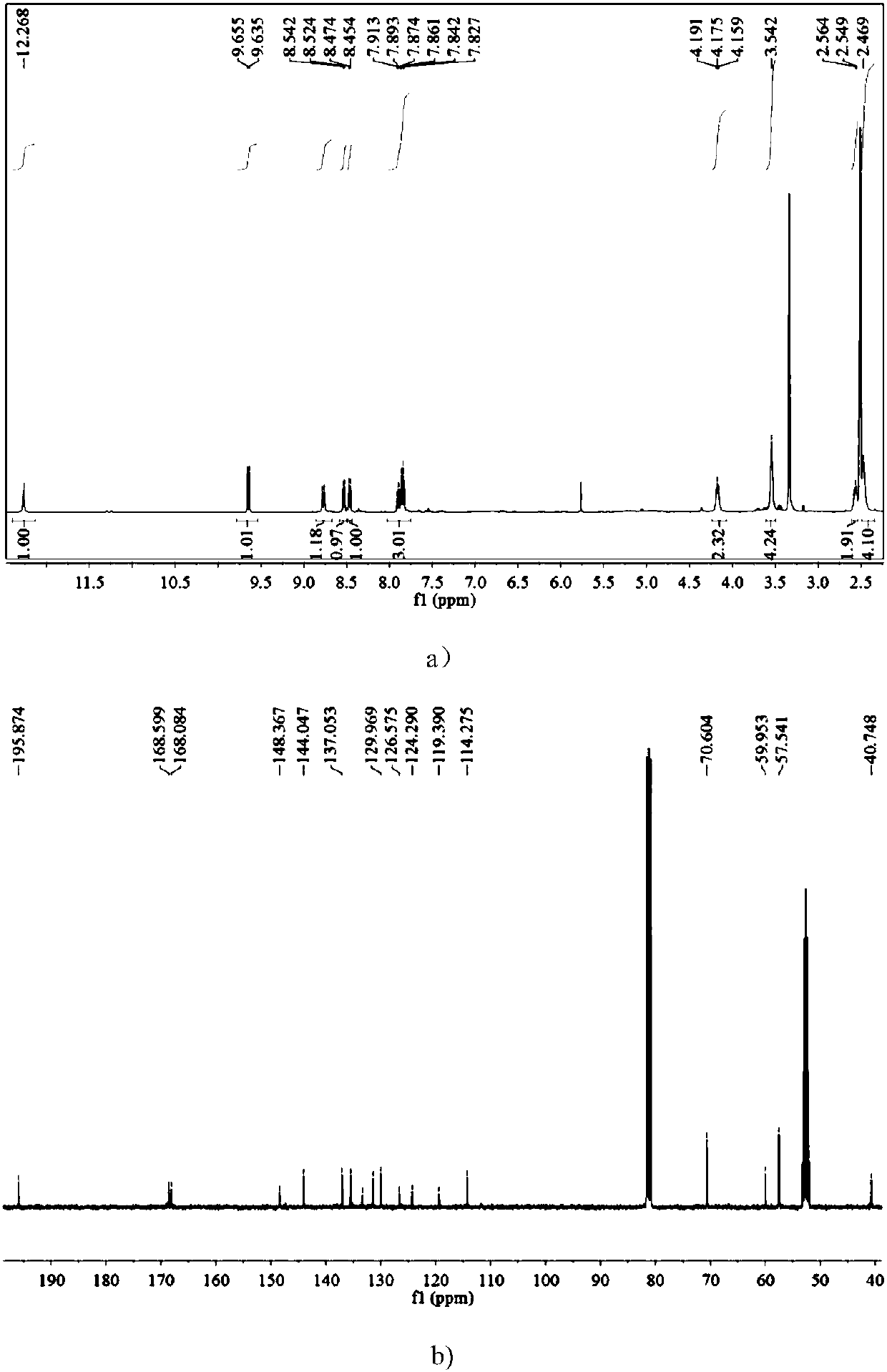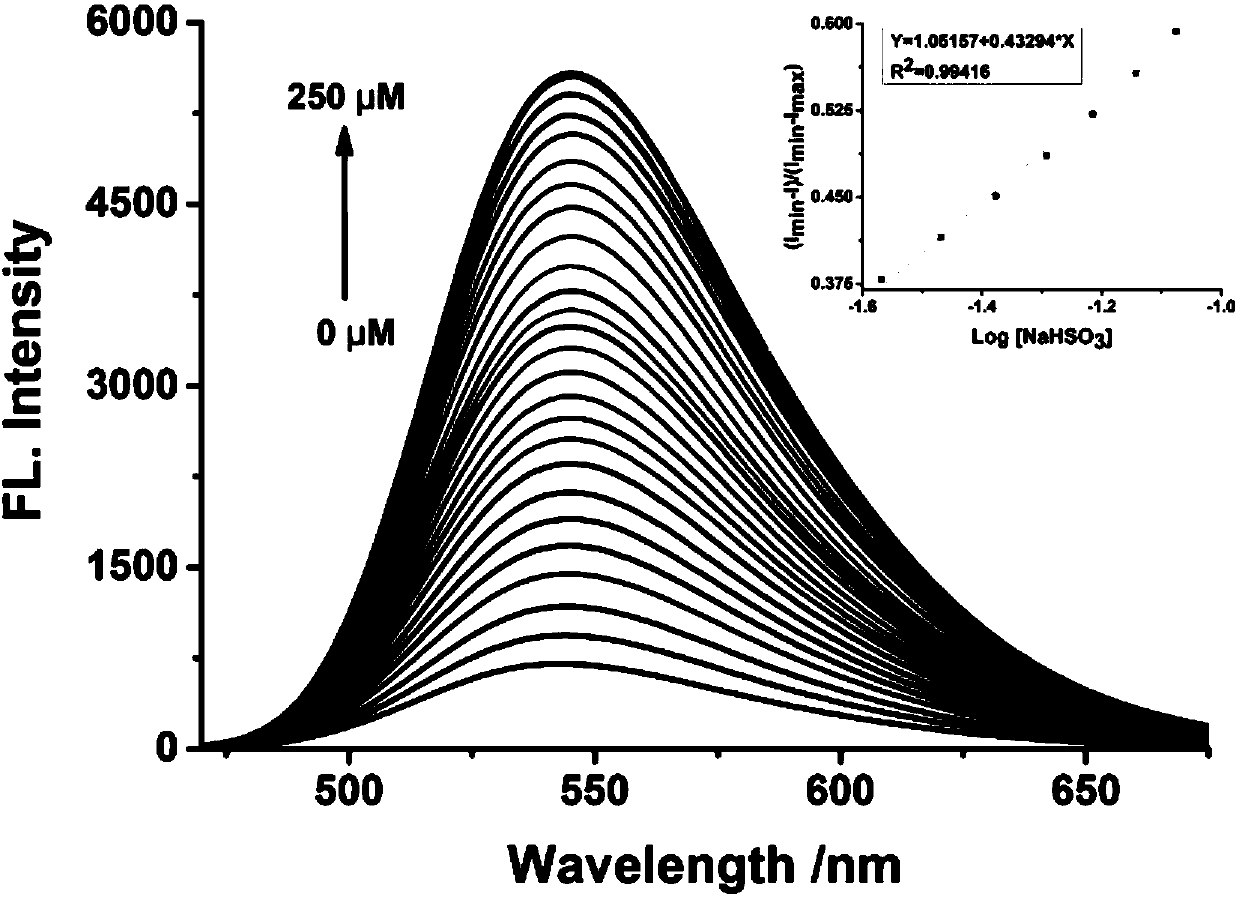Lysosome target fluorescent probe of sulfur dioxide/sulfurous acid (hydrogen) saline
A fluorescent probe, sulfur dioxide technology, applied in the field of sulfur dioxide fluorescent probes, can solve the problems of fluorescent probes such as long response time and scattering interference, and achieve the effects of fast recognition speed, good specificity and high yield
- Summary
- Abstract
- Description
- Claims
- Application Information
AI Technical Summary
Problems solved by technology
Method used
Image
Examples
Embodiment 1
[0036] Example 1 Synthesis of a lysosome-targeted fluorescent probe for rapid detection of sulfur dioxide
[0037] (1) Synthesis of Compound 1
[0038] ;
[0039] In a 100 mL round bottom flask, the compound N-(2-aminoethyl)morpholine (1.30 g, 10 mmol) was added and mixed with 1,8-4-bromonaphthalic anhydride (2.77 g, 10 mmol), Add 30 mL of ethanol to it and stir under reflux, cool to room temperature, place the reaction system in a -5 °C environment, a large amount of solids precipitate, filter under reduced pressure, wash the filter cake with ethanol 2-3 times, and dry in vacuo to obtain compound 1 . The crude product was recrystallized from ethanol to obtain pure product. Yield: 88%.
[0040] (2) Synthesis of compound 2
[0041] ;
[0042] In a 100 mL round bottom flask, add 30 mL of ethanol, add compound 1 (1.945 g, 5 mmol), 80% hydrazine hydrate (1.00 g, 25 mmol), heat and reflux for 2-3 h, then cool to Filter under reduced pressure at room temperature, wash the...
Embodiment 2
[0046] Example 2 Compound Na-SO 2 -Lyso detects the fluorescence intensity of different concentrations of sodium bisulfite.
[0047] Preparation concentration is the fluorescent probe Na-SO obtained in embodiment 1 of 1 mM 2 -Lyso's acetonitrile test stock solution ready for use.
[0048]The final concentration of the probe was 10 μM, and PBS solution (pH 5.5) containing 5% acetonitrile solution was mixed with different concentrations of sodium bisulfite (1 μM, 3 μM, 6 μM, 10 μM, 15 μM, 21 μM, 27 μM, 34 μM, 42 μM, 51μM, 61μM, 72μM, 84μM, 97μM, 110μM, 121μM, 132μM, 143μM, 154μM, 170μM, 186μM, 200μM, 215μM, 230μM, 240μM, 250μM, 260μM) full effect, for fluorescence detection (λ ex =440 nm, λ em =545 nm). The fluorescence intensity in each system was obtained, and the standard curve of fluorescence intensity and sodium bisulfite concentration was established, and the results were as follows: figure 2 shown. Depend on figure 2 It can be seen that as the concentration of so...
Embodiment 3
[0049] Example 3 Compound Na-SO 2 - Kinetic test of Lyso in PBS buffer.
[0050] Preparation concentration is the fluorescent probe Na-SO obtained in embodiment 1 of 1 mM 2 -Lyso's acetonitrile test stock solution ready for use.
[0051] Prepare the probe with a final concentration of 10 μM, PBS solution (pH 5.5) containing 5% acetonitrile solution, fully react with sodium bisulfite (250 μM), and perform fluorescence detection every three seconds (λ ex =440 nm, λ em =545 nm). The fluorescence intensity in each system was obtained, and the standard curve of fluorescence intensity and time was established, such as image 3 shown. Depend on image 3 It can be seen that with the increase of time, the fluorescence intensity at 545 nm increases gradually, and the reaction reaches equilibrium within 9 s.
PUM
 Login to View More
Login to View More Abstract
Description
Claims
Application Information
 Login to View More
Login to View More - R&D
- Intellectual Property
- Life Sciences
- Materials
- Tech Scout
- Unparalleled Data Quality
- Higher Quality Content
- 60% Fewer Hallucinations
Browse by: Latest US Patents, China's latest patents, Technical Efficacy Thesaurus, Application Domain, Technology Topic, Popular Technical Reports.
© 2025 PatSnap. All rights reserved.Legal|Privacy policy|Modern Slavery Act Transparency Statement|Sitemap|About US| Contact US: help@patsnap.com



